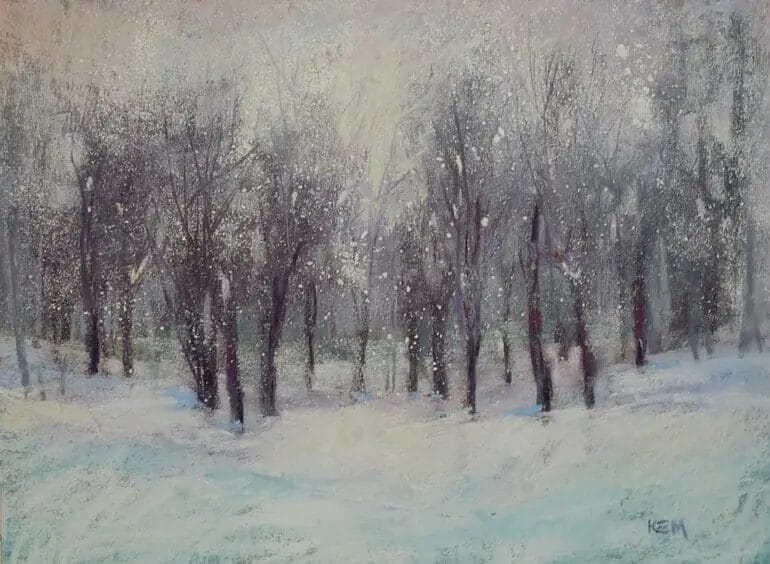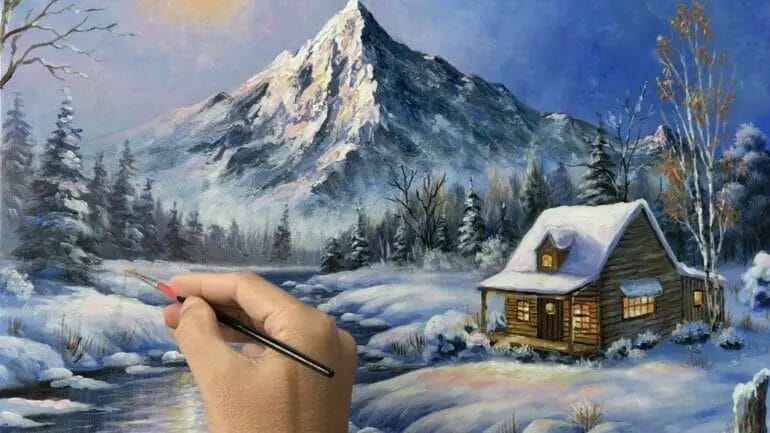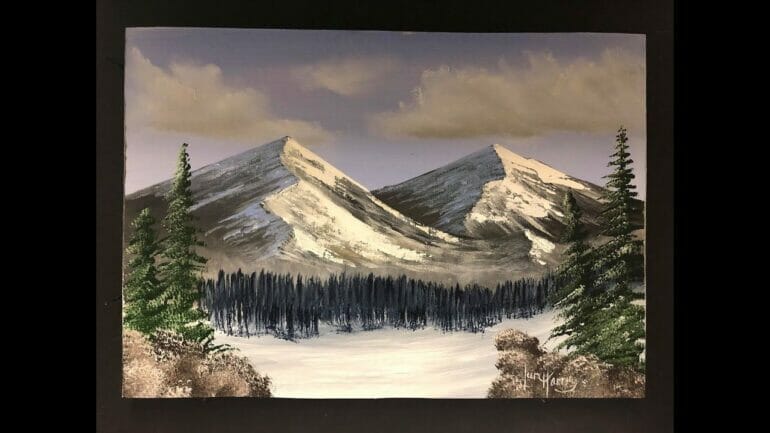Painting snow with acrylics can be a challenging yet rewarding experience for artists. With the versatility of acrylic paints, you can capture the serene beauty and texture of snow on your canvas.
Start by selecting the right shades of white and blue to create depth and dimension in your painting. Layering various tones and adding soft shadows will help bring the snow to life.
Using different brush techniques such as dry brushing or stippling can mimic the unique texture of freshly fallen snow. Incorporate subtle hints of other colors, like pale purples or grays, to add interest and realism to your snowy landscape.
Remember to observe the way light interacts with snow, creating highlights and shadows. Experiment with different brush sizes and strokes to create varying effects and capture the intricate details of a winter wonderland.
With practice and experimentation, you can master the art of painting snow with acrylics and convey its ethereal beauty on your canvas. So, grab your brushes and let your creativity soar as you create your own stunning snowy landscapes.

Mastering the Art of Painting Snow with Acrylics: Essential Steps and Tricks
Painting snow with acrylics can be a challenging task, but with the right techniques and tricks, you can master the art and create stunning winter landscapes that capture the beauty of a snowy scene. In this section, we will explore the essential steps and tricks to help you perfect your snow painting skills.
1. Choosing the Right Colors
The first step in painting snow with acrylics is selecting the right colors. Contrary to popular belief, snow isn’t just pure white. It tends to reflect the surrounding colors and light. To achieve a realistic snow effect, use a combination of cool whites and pale blues to capture the subtle hues and shadows of snow.
2. Preparing the Canvas
Before you begin painting, it’s important to prepare your canvas properly. Start by applying a thin layer of gesso to create a smooth and even surface. This will ensure that the paint adheres well to the canvas and prevents any unwanted textures from interfering with your snow painting.
3. Building Layers
To achieve depth and texture in your snow painting, it’s crucial to build multiple layers of paint. Start with a light base layer and gradually add darker tones to create shadows and highlights. Use a dry brush technique to add texture and mimic the uneven surface of snow.
4. Creating Shadows and Highlights
The key to realistic snow painting lies in the ability to capture the subtle shadows and highlights. Use a mix of blues, grays, and purples to create shadows in the snow. For highlights, mix a small amount of white paint with a touch of pale yellow or blue to achieve a soft glow.
5. Adding Texture
To give your snow painting a realistic texture, experiment with different techniques such as stippling, dry brushing, and palette knife painting. These techniques will help you create the illusion of individual snowflakes and the uneven texture of freshly fallen snow.
6. Painting Snow-covered Trees and Objects
When painting snow-covered trees or objects, pay attention to the way snow accumulates and clings to different surfaces. Use a light touch and short, flicking brushstrokes to depict snow on branches and rooftops. Add shadows and highlights to create depth and dimension.
7. Capturing the Mood
One of the most important aspects of painting snow is capturing the mood and atmosphere of a winter landscape. Use soft, cool colors to convey a sense of serenity and tranquility. Experiment with different brushstrokes and techniques to add movement and depth to your painting.
8. Adding Final Details
Once you’ve completed the main elements of your snow painting, it’s time to add the final details. Pay attention to the smaller details such as footprints, snowdrifts, and the sparkle of sunlight on the snow. These subtle touches can elevate your painting and make it more realistic.
9. Practice, Patience, and Perseverance
Mastering the art of painting snow with acrylics takes practice, patience, and perseverance. Don’t be discouraged if your first attempts don’t turn out as expected. Keep experimenting, learning from your mistakes, and refining your technique. With time and dedication, you will become more proficient in capturing the beauty of snow in your paintings.
In summary, painting snow with acrylics requires a combination of the right colors, layering techniques, and attention to detail. By following the essential steps and tricks outlined in this section, you can enhance your skills and create breathtaking winter landscapes that truly capture the magic of a snowy scene.

From Blank Canvas to Winter Wonderland: Step-by-Step Acrylic Snow Painting Tutorial
Are you ready to dive into the world of winter wonderland art? In this section, we will take you through a step-by-step tutorial on creating a beautiful acrylic snow painting. Whether you’re a beginner or an experienced artist, this tutorial will guide you through the process of turning a blank canvas into a breathtaking winter scene.
Materials Needed
Before we begin, gather the following materials:
- Canvas
- Acrylic paints (white, blue, and various shades of gray)
- Palette knife or paintbrush
- Water cup
- Paper towels
- Palette or a disposable plate
- Reference photo or inspiration
Step 1: Prepare Your Workspace
Find a well-lit and comfortable space to work on your painting. Lay out your materials and make sure your canvas is clean and free of any dust or debris. It’s important to have a clutter-free workspace to fully immerse yourself in the painting process.
Step 2: Sketch Your Composition
Using a pencil or a light-colored charcoal pencil, lightly sketch the main elements of your winter scene. This will act as your guideline while painting. Start with the horizon line, then add trees, mountains, or any other elements you want to include in your painting.
Step 3: Start with the Sky
Dip your paintbrush or palette knife into the blue acrylic paint and start applying it to the top portion of your canvas. Use broad strokes to create a smooth and even layer of paint. Blend in some white paint to create a gradient effect, mimicking a snowy sky. Remember to paint in the direction of your horizon line.
Step 4: Paint the Background
With various shades of gray acrylic paint, start painting the background elements such as mountains or distant trees. Use different brush strokes and techniques to add depth and texture to the scene. Start with lighter shades of gray and gradually add darker tones as you move closer to the foreground.
Step 5: Add the Main Elements
Now it’s time to bring your painting to life by adding the main elements like trees, cabins, or any focal point you want to showcase. Use a smaller brush or palette knife to add details and highlights. Remember to paint in layers, starting with the lighter shades and gradually adding darker tones.
Step 6: Create Snowy Textures
To give your painting a realistic snowy look, mix white paint with a touch of gray and apply it using a palette knife. Use quick and short strokes to create the texture of snow on tree branches, rooftops, or any other areas you want to highlight. Don’t be afraid to experiment and play around with different techniques to achieve the desired effect.
Step 7: Final Touches
Take a step back and assess your painting. Add any final touches or adjustments to enhance the overall composition. Pay attention to details such as shadows, highlights, and reflections to make your winter scene come alive. Allow your painting to dry completely before signing your name and displaying it proudly in your home.
Summary
Creating a winter wonderland painting can be a rewarding and enjoyable experience. By following this step-by-step acrylic snow painting tutorial, you can unleash your creativity and bring a touch of magic to your canvas. Remember to have fun, experiment with different techniques, and let your imagination guide you in creating a beautiful winter masterpiece.

Capturing the Beauty of Snow with Acrylics: Exploring Texture, Light, and Color
Winter landscapes covered in a blanket of snow evoke a sense of serenity and beauty. The soft, white flakes delicately resting on tree branches and the ground create a breathtaking scene. As an artist, capturing the essence and beauty of snow can be both challenging and rewarding. In this section, we will explore how to use acrylic paints to create stunning snowscapes with a focus on texture, light, and color.
Understanding the Texture of Snow
One of the most important aspects of painting snow is recreating its unique texture. Snow is not just a flat, uniform surface; it has depth and variety. To achieve this texture, start by using a palette knife instead of a brush. Load the knife with white acrylic paint and create small, gentle strokes on the canvas. This will give your painting the appearance of individual snowflakes and add a sense of realism.
In addition to the palette knife technique, you can also experiment with other tools to create texture. Try using a sponge or a stiff-bristled brush to add depth and variation to the snow. Dabbing the paint in different directions will mimic the unevenness of real snow, making your painting more lifelike.
Playing with Light and Shadows
Light and shadows play a vital role in depicting the beauty of snow. The way light interacts with the snow can transform a simple scene into a breathtaking winter wonderland. When painting snow, it is essential to observe the light source and understand how it affects the snow’s appearance.
To create realistic lighting effects, first determine the direction of the light source in your painting. This will help you identify where the highlights and shadows should be placed. Use a light gray or a cool-toned white to paint the areas where the light hits the snow directly. These highlights will bring a sense of brightness and sparkle to your artwork.
Next, deepen the shadows by adding a touch of blue or purple to your white paint. Shadows in the snow are not pure black but rather have subtle hues that reflect the surrounding environment. By carefully layering these shadow tones, you can create a sense of depth and three-dimensionality.
Exploring Color in Snowscapes
Contrary to popular belief, snow is not just pure white. It reflects the colors of its surroundings, creating a beautiful interplay of hues. When painting a snowscape, experiment with incorporating different colors to add visual interest and depth.
Start by adding cool tones to your white paint. Blues, purples, and grays can give the illusion of shadows and create a more realistic representation of snow. Additionally, consider incorporating warm tones like pale yellows or pinks to capture the subtle warmth and glow that can be present in the winter landscape.
Don’t be afraid to experiment and mix colors to find the perfect balance. Remember, nature is diverse, and snowscapes offer a wide range of color possibilities. Embrace this opportunity to add your own artistic touch to your painting.
Summary
Capturing the beauty of snow with acrylics allows artists to express the serenity and charm of winter landscapes. Understanding the texture of snow and using tools like palette knives, sponges, and brushes can add depth and realism to your artwork. Playing with light and shadows enhances the overall atmosphere of the snowscape, while exploring different colors adds visual interest. With practice and experimentation, you can master the art of painting snow with acrylics and create stunning winter scenes that evoke the magic of the season.
Unleash Your Creativity: Discover Unique Styles in Acrylic Snow Painting
Acrylic snow painting is a fascinating art form that allows artists to create stunning winter landscapes with depth and texture. Unlike traditional snow paintings that rely on white paint for snow, acrylic snow painting introduces a variety of colors, techniques, and styles to depict the beauty and uniqueness of snow-covered scenes. In this section, we will explore some unique styles in acrylic snow painting that will inspire you to unleash your creativity.
1. Impasto Technique
The impasto technique in acrylic snow painting involves applying thick layers of paint onto the canvas to create a three-dimensional effect. This technique allows the artist to mimic the texture and depth of real snow. By using a palette knife or a brush with stiff bristles, you can create bold and textured strokes that give the illusion of snow-covered landscapes.
2. Glazing Technique
The glazing technique in acrylic snow painting involves applying thin, translucent layers of paint over a dry base layer. This technique allows you to build up layers of color and create a sense of depth and luminosity in your snow paintings. By selectively glazing certain areas with cool blues and purples, you can capture the gleam of light on the snow.
3. Wet-on-Wet Technique
The wet-on-wet technique in acrylic snow painting involves applying wet paint onto a wet surface. This technique allows the colors to blend and mix spontaneously, creating soft edges and subtle transitions in your snow paintings. By working quickly and loosely, you can capture the freshness and spontaneity of a snowy scene.
4. Textured Snow Technique
The textured snow technique in acrylic snow painting involves using various tools and materials to create interesting textures in the snow. You can use a palette knife, a toothbrush, or even cling wrap to achieve different effects. By layering different shades of white, gray, and blue paint with textured strokes, you can create a realistic and tactile representation of snow.
5. Monochromatic Snowscape
The monochromatic snowscape style in acrylic snow painting involves using a limited color palette to create a serene and minimalist winter scene. By using various shades of white, gray, and blue, you can convey a sense of tranquility and stillness in your snowscapes. This style is perfect for capturing the quiet beauty of a snowy landscape.
6. Expressive Snowflakes
The expressive snowflakes style in acrylic snow painting allows you to focus on capturing the intricate and delicate details of snowflakes. By using a fine brush or even a toothpick, you can paint individual snowflakes with intricate patterns and shapes. This style adds a touch of whimsy and enchantment to your snow paintings.
7. Realistic Snow Scene
The realistic snow scene style in acrylic snow painting aims to capture the true essence and realism of a snowy landscape. By carefully observing the play of light and shadows on the snow, you can recreate the subtle nuances and reflections that make a snow scene come to life. This style requires patience and attention to detail to achieve a truly realistic depiction of snow.
In summary, acrylic snow painting offers a world of creative possibilities. Whether you prefer bold and textured strokes or subtle and delicate details, there is a unique style for everyone to explore. Experiment with different techniques and embrace your creativity to create stunning snowscapes that capture the magic and beauty of winter.
Frequently Asked Questions
1. How can I paint snow with acrylics?
To paint snow with acrylics, start by applying a thin, even layer of white paint as the base. Then, use a mix of light blues and grays to create shadows and highlights. Add texture to the snow by using a dry brush technique or by dabbing on paint with a sponge. Experiment with different brush strokes and layering to achieve a realistic snowy effect.
2. What colors should I use to paint snow?
When painting snow, it’s important to use a combination of cool colors such as white, light blues, and grays. White will be the main color, but adding subtle tints of blue and gray will help create depth and realism. Avoid using pure white straight from the tube, as it can appear flat and unrealistic.
3. How can I create the illusion of depth in my snow painting?
To create the illusion of depth in your snow painting, use a combination of lighter and darker shades of white, blue, and gray. Paint the foreground snow with more texture and detail, while gradually reducing the level of detail in the background. This gradual fading of details will give the impression of distance and depth in your snowscape.
Conclusion:
In conclusion, painting snow with acrylics can be a delightful and rewarding experience. By mastering certain techniques and employing the right tools, you can create beautiful winter landscapes that capture the essence of a snowy day.
The key to successfully painting snow with acrylics lies in understanding the interplay of light and shadows. By using varying shades of white and blue, you can add depth and dimension to your painting, making the snow appear realistic.
Remember to experiment with different brush strokes and texture techniques to mimic the unique characteristics of snow. Whether you’re a beginner or an experienced artist, with practice and patience, you can master the art of painting snow with acrylics and create stunning winter scenes that evoke a sense of tranquility and wonder.
